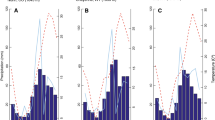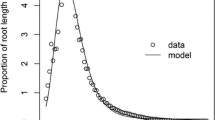Abstract
Although the use of minirhizotrons is increasing, many gaps in our scientific understanding of root systems remain. For example, relatively few studies have examined root responses to nutrient additions and mowing treatments in restored North American grasslands. In this project, we employed a combination of methods to evaluate the above- and belowground portions of restored grassland plots in western North Dakota (mixed grass prairie; 405 mm average annual precipitation). The plots were planted with various species combinations (1–20) and subjected to 5 years of nutrient additions (N, P, or control) and 3 years of mowing treatments (yearly fall mowing or no mowing). In general, we found the belowground variables (root length, surface area, number of tips, and number of branches) to be relatively unresponsive to the nutrient and mowing treatments. For instance, average root length was 309, 315, and 300 cm in the nitrogen, phosphorus, and control plots, respectively. In contrast, the aboveground variables exhibited pronounced responses to nitrogen applications (200 kg/ha year). Nitrogen applications increased aboveground biomass (660 vs. 265 g/m2, respectively) and reduced average species richness compared to the control (3.25 species vs. 7.29 species, respectively). Our results indicated that the root systems in the plots that received nitrogen were able to support more aboveground biomass than were similarly sized root systems in plots that did not receive nitrogen. However, the observed increase in aboveground biomass came at a cost, as species richness was lower in the plots that received nitrogen.


Similar content being viewed by others
References
Baer SG, Kitchen DJ, Blair JM, Rice CW (2002) Changes in ecosystem structure and function along a chronosequence of restored grasslands. Ecol Appl 12:1688–1701
Balogianni VG, Wilson SD, Vaness BM, MacDougall AS, Pinno BD (2014) Different root and shoot responses to mowing and fertility in native and invaded grassland. Rangeland Ecol Manag 67:39–45
Biondini ME (2007) Plant diversity, production, stability, and susceptibility to invasion in restored northern tall grass prairies (United States). Restor Ecol 15:77–87
Biondini ME, Patton BD, Nyren PE (1998) Grazing intensity and ecosystem processes in a northern mixed-grass prairie, USA. Ecol Appl 8:469–479
Biondini ME, Norland JE, Grygiel CE (2011) Plant richness-biomass relationships in restored northern Great Plains grasslands (USA). Int J Ecol. doi:10.1155/2011/856869
Bloom AJ, Chapin FS III, Mooney HA (1985) Resource limitation in plants—an economic analogy. Annu Rev Ecol Syst 16:363–392
Box JE, Smucker AJM, Ritchie JT (1989) Minirhizotron installation techniques for investigating root responses to drought and oxygen stress. Soil Sci Soc Am J 53:115–118
Cahill JF (1999) Fertilization effects on interactions between above- and belowground competition in an old field. Ecology 80:466–480
Campbell NE, Reece JB (2002) Biology, 6th edn. Benjamin Cummings, San Francisco
Craine JM, Wedin DA, Chapin FS III, Reich PB (2002) Relationship between the structure of root systems and resource use for 11 North American grassland plants. Plant Ecol 165:85–100
Crocker TL, Hendrick RL, Ruess RW, Pregitzer KS, Burton AJ, Allen MF, Shan J, Morris LA (2003) Substituting root numbers for length: improving the use of minirhizotrons to study fine root dynamics. Appl Soil Ecol 23:127–135
Dahlman RC, Kucera CL (1965) Root production and turnover in native prairie. Ecology 46:84–89
DiAllesandro A, Kobiela BP, Biondini ME (2013) Invasion as a function of species diversity: a case study of two restored North Dakota grasslands. Ecol Restor 31:186–194
Evert RF, Eichhorn SE (2013) Raven biology of plants, 8th edn. WH Freeman and Company, New York
Fitter AH (1987) An architectural approach to the comparative ecology of plant root systems. New Phytol 106:61–77
Fitter A (2002) Characteristics and functions of root systems. In: Waisel Y, Eshel A, Kafkafi U (eds) Plant roots: the hidden half, 3rd edn. Marcel Dekker, New York, pp 15–32
Gao YZ, Giese M, Lin S, Sattelmacher B, Zhao Y, Brueck H (2008) Belowground net primary productivity and biomass allocation of a grassland in Inner Mongolia is affected by grazing intensity. Plant Soil 307:41–50
Gregory P (2006) Plant roots: growth, activity, and interaction with soils. Blackwell, Oxford
Gurevitch J, Scheiner SM, Fox GA (2006) The ecology of plants, 2nd edn. Sinauer Associates, Sunderland
Gusewell S (2004) N: P ratios in terrestrial plants: variation and functional significance. New Phytol 164:243–266
Hendricks JJ, Hendrick RL, Wilson CA, Mitchell RJ, Pecot SD, Guo D (2006) Assessing the patterns and controls of fine root dynamics: an empirical test and methodological review. J Ecol 94:40–57
Henry F, Nguyen C, Paterson E, Sim A, Robin C (2005) How does nitrogen availability alter rhizodeposition in Lolium multiflorum Lam. during vegetative growth? Plant Soil 269:181–191
Hodge A, Berta G, Doussan C, Merchan F, Crespi M (2009) Plant root growth, architecture and function. Plant Soil 321:153–187
Hui D, Jackson RB (2006) Geographical and interannual variability in biomass partitioning in grassland ecosystems: a synthesis of field data. New Phytol 169:85–93
Jackson RB, Caldwell MM (1989) The timing and degree of root proliferation in fertile-soil microsites for three cold-desert perennials. Oecologia 81:149–153
Jackson RB, Canadell J, Ehleringer JR, Mooney HA, Sala OE, Schulze ED (1996) A global analysis of root distributions for terrestrial biomes. Oecologia 108:389–411
Johnson HA, Biondini ME (2001) Root morphological plasticity and nitrogen uptake of 59 plant species from the Great Plains grasslands, USA. Basic Appl Ecol 2:127–143
Johnson MG, Tingey DT, Phillips DL, Storm MJ (2001) Advancing fine root research with minirhizotrons. Environ Exp Bot 45:263–289
Kembel SW, Cahill JF Jr (2005) Plant phenotypic plasticity belowground: a phylogenetic perspective on root foraging trade-offs. Am Nat 166:216–230
Kitchen DJ, Blair JM, Callaham MA Jr (2009) Annual fire and mowing alter biomass, depth distribution, and C and N content of roots and soil in tallgrass prairie. Plant Soil 323:235–247
Kucharik CJ, Fayram NJ, Nicholas Cahill K (2006) A paired study of prairie carbon stocks, fluxes, and phenology: comparing the world’s oldest prairie restoration with an adjacent remnant. Glob Change Biol 12:122–139
Ladwig LM, Collins SL, Swann AL, Xia Y, Allen MF, Allen EB (2011) Above- and belowground responses to nitrogen addition in a Chihuahuan Desert grassland. Oecologia. doi:10.1007/s00442-011-2173-z
Lesica P, DeLuca TH (1996) Long-term harmful effects of crested wheatgrass on Great Plains grassland ecosystems. J Soil Water Cons 51:408–409
Levang-Brilz N, Biondini ME (2002) Growth rate, root development and nutrient uptake of 55 plant species from the Great Plains grasslands, USA. Plant Ecol 165:117–144
McCune B, Grace JB (2002) Analysis of ecological communities. MjM Software Desgin, Gleneden Beach
Mueller KE, Tilman D, Fornara DA, Hobbie SE (2013) Root depth distribution and the diversity-productivity relationship in a long-term grassland experiment. Ecology 94:787–793
Munson SM, Lauenroth WK (2012) Plant community recovery following restoration in semiarid grasslands. Restor Ecol 20:656–663
Paradeis BL, DeKeyser ES, Kirby DR (2010) Evaluation of restored and native Prairie Pothole Region plant communities following an environmental gradient. Nat Area J 30:294–311
Polomski J, Kuhn N (2002) Root research methods. In: Waisel Y, Eshel A, Kafkafi U (eds) Plant roots: the hidden half, 3rd edn. Marcel Dekker, New York, pp 295–321
Pucheta E, Cabido M, Diaz S, Funes G (1998) Floristic competition, biomass, and aboveground net plant production in grazed and protected sites in a mountain grassland of central Argentina. Acta Oecol 19:97–105
Pucheta E, Bonamici I, Cabido M, Diaz S (2004) Below-ground biomass and productivity of a grazed site and a neighbouring ungrazed exclosure in a grassland in central Argentina. Austral Ecol 29:201–208
Quinn GP, Keough MJ (2002) Experimental design and analysis for biologists. Cambridge University Press, New York
Robinson D (1996) Resource capture by localized root proliferation: why do plants bother? Ann Bot 77:179–185
Son Y, Hwang JH (2003) Fine root biomass, production and turnover in a fertilized Larix leptolepis plantation in central Korea. Ecol Restor 18:339–346
Stanton NL (1988) The underground in grasslands. Annu Rev Ecol Syst 19:573–589
Sun G, Coffin DP, Lauenroth WK (1997) Comparison of root distributions of species in North American grasslands using GIS. J Veg Sci 8:587–596
Turner CL, Seastedt TR, Dyer MI (1993) Maximization of aboveground grassland production: the role of defoliation frequency, intensity, and history. Ecol Appl 3:175–186
United States Department of Agriculture—Farm Service Agency (USDA-FSA) (2015) Conservation reserve program statistics. http://www.fsa.usda.gov/programs-and-services/conservation-programs/reports-and-statistics/conservation-reserve-program-statistics/index. Accessed on 11 Dec 2015
van Dyke F, Van Kley SE, Page CE, Van Beek JG (2004) Restoration efforts for plant and bird communities in tallgrass prairies using prescribed burning and mowing. Restor Ecol 12:575–585
Vaness BM, Wilson SD, MacDougall AS (2014) Decreased root heterogeneity and increased root length following grassland invasion. Funct Ecol 28:1266–1273
Vinton MA, Goergen EM (2006) Plant-soil feedbacks contribute to the persistence of Bromus inermis in tallgrass prairie. Ecosystem 9:967–976
Weaver JE (1919) The ecological relations of roots. Carnegie Institute of Washington, Washington DC
Weaver JE, Clements FE (1938) Plant ecology, 2nd edn. McGraw-Hill, New York
Wilson SD (2014) Below-ground opportunities in vegetation science. J Veg Sci 25:1117–1125
Yavitt JB, Harms KE, Garcia MN, Mirabello MJ, Wright SJ (2011) Soil fertility and fine root dynamics in response to 4 years of nutrient (N, P, K) fertilization in a lowland tropical moist forest, Panama. Austral Ecol 36:433–445
Acknowledgments
The authors are grateful to J. Norland, T. DeSutter, G. Clambey, C. Grygiel, K. Horsager, K. Ringwall, A. DiAllesandro, and K. Graber for their invaluable help on this project. The feedback from two anonymous reviewers truly improved this manuscript. Financial support was provided by the National Science Foundation DEB-9627928 and the United States Department of Agriculture NRICGP 93-0051 and 99-00979.
Author information
Authors and Affiliations
Corresponding author
Additional information
Communicated by Lori Biederman.
Appendices
Appendix 1
See Table 4.
Appendix 2
See Table 5.
Rights and permissions
About this article
Cite this article
Kobiela, B., Biondini, M. & Sedivec, K. Comparing root and shoot responses to nutrient additions and mowing in a restored semi-arid grassland. Plant Ecol 217, 303–314 (2016). https://doi.org/10.1007/s11258-016-0571-3
Received:
Accepted:
Published:
Issue Date:
DOI: https://doi.org/10.1007/s11258-016-0571-3




